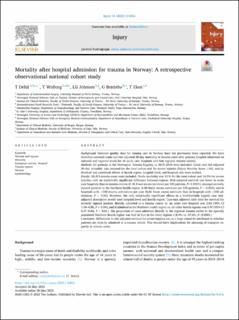| dc.description.abstract | Background
National quality data for trauma care in Norway have not previously been reported. We have therefore assessed crude and risk-adjusted 30-day mortality in trauma cases after primary hospital admission on national and regional levels for 36 acute care hospitals and four regional trauma centres.
Methods
All patients in the Norwegian Trauma Registry in 2015–2018 were included. Crude and risk-adjusted 30-day mortality was assessed for the total cohort and for severe injuries (Injury Severity Score ≥16), and individual and combined effects of health region, hospital level, and hospital size were studied.
Results
28,415 trauma cases were included. Crude mortality was 3.1% for the total cohort and 14.5% for severe injuries, with no statistically significant difference between regions. Risk-adjusted survival was lower in acute care hospitals than in trauma centres (0.48 fewer excess survivors per 100 patients, P<0.0001), amongst severely injured patients in the Northern health region (4.80 fewer excess survivors per 100 patients, P = 0.004), and in hospitals with <100 trauma admissions per year (0.65 fewer excess survivors than in hospitals with ≥100 admissions, P = 0.01). However, the only statistically significant effects in a multivariable logistic case mix-adjusted descriptive model were hospital level and health region. Case-mix adjusted odds ratio for survival for severely injured patients directly admitted to a trauma centre vs. an acute care hospital was 2.04 (95% CI 1.04–4.00, P = 0.04), and if admitted in the Northern health region vs. all other health regions was 0.47 (95% CI 0.27–0.84, P = 0.01). The proportion of cases admitted directly to the regional trauma centre in the sparsely populated Northern health region was half of that in the other regions (18.4% vs. 37.6%, P<0.0001).
Conclusion
Differences in risk-adjusted survival for severe injuries can to a large extent be attributed to whether patients are directly admitted to a trauma centre. This should have implications for planning of transport capacity in remote areas. | en_US |

